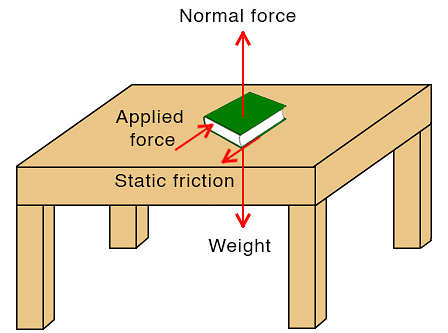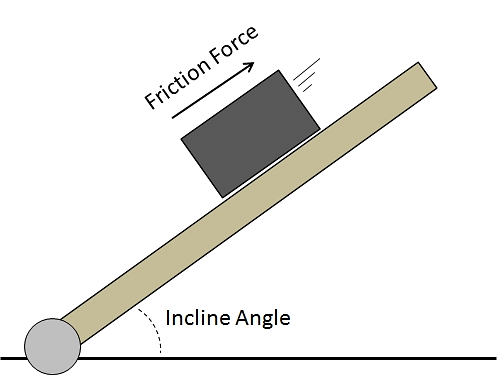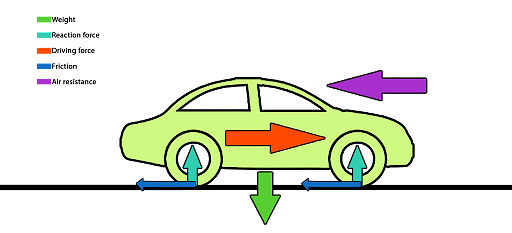Jasmine Grover Content Strategy Manager
Content Strategy Manager
Friction in automobiles plays a very vital role. Automobiles wouldn’t even exist if friction did not exist. Have you ever noticed when you roll a ball on the ground, it stops after some time? This is because the ball is subjected to friction as the opposing force. Any object moving over a surface will slow down when an external force is not applied and it finally stops. This is because of friction between the object and the surface. If friction did not exist, the ball, or rather any object would never stop. The same frictional force is utilized in automobiles to stop them when the brake is pressed, take turns, and even for starting the vehicle. In simple words, frictional force can be referred to as the opposing force or resistance created by the irregularities in the surface of two objects moving over each other. We will learn more about friction and its role in automobiles in this article.
Read Also: Angular Speed
| Table of Content |
Key takeaways: Frictional force, friction in automobiles, rolling friction, sliding friction, static friction, fluid friction
What is Friction?
[Click Here for Sample Questions]
Friction force can be referred to as the force that resists the relative motion between two objects. It is generated when two objects slide upon each other. The microscopic irregularities present on the surface cause friction. The higher the level of irregularities or roughness, the greater is the force of friction. The direction of frictional force is always opposite to the direction of relative motion between two surfaces and is always parallel to the surface of contact.

Frictional force acting between two surfaces
Check Important Notes for Derivation of Centripetal Acceleration
Types of Friction
[Click Here for Sample Questions]
Friction can be classified into four kinds namely static friction, sliding friction, rolling friction, and fluid friction.
Static friction
The frictional force acting between two bodies, when both of them are at rest is called static friction. This is the force required to move an object at rest. An example of static friction is a car parked in a slanting position.
The static force is given by the formula,
Fs = μs × Fn
Where,
Fs = static friction
μs = coefficient of static friction
Fn = normal force

Example of static friction
Read More: Static Friction Formula
Sliding friction
Sliding friction is the friction acting between two surfaces that are sliding upon each other. Sliding friction is equal to the force required to keep an object moving at the same speed. You must have noticed that it requires less force to keep an object moving, than moving it from rest. So, sliding friction is smaller than static friction.
The sliding force is given by the formula,
Fs = μs × Fn
Where,
Fs = sliding friction
μs = coefficient of sliding friction
Fn = normal force

Example of sliding friction
Check Further: Impending Motion
Rolling friction
Rolling friction is the force required to keep an object rolling on the surface of another object. Note that rolling and sliding are two different motions. Imagine pushing a trolley without wheels and with wheels. The one with wheels will be much easier to push compared to the troller with no wheels. This is because rolling reduces friction. So, rolling friction is smaller than sliding friction.
The rolling friction is given by
Fr =μrW
Where, Fr = Rolling friction
μr = coefficient of rolling resistance
W = rolling body’s weight

Example of rolling friction
Fluid friction
Fluid is the common name used for both liquids and gasses. The resistance exerted by the fluid on an object moving within the fluid is called fluid friction. Fluid friction depends on the relative speed of the object and the shape of the object.
Have you wondered, why are airplanes designed in a specific shape? It is because this particular shape reduces the fluid friction between air and the airplane.
Read More: Types of friction
Role of Friction in Automobiles
[Click Here for Sample Questions]
If friction did not exist, an object that started moving would continue to move forever and would never stop. The same thing happens with cars. Have you noticed the tires of cars, buses, and trucks? It has ridges on its surface, this is to increase the static friction between the tire and the road. Friction is required to start and stop the vehicle and take turns to change direction.

Frictional forces acting on a moving car
- When you start a car, the tires start pushing against the road. As we already know, friction acts in the opposite direction of force applied, so the friction acting between the tires and the road pushes the car in forward motion, and the car starts “rolling” forward.
- While turning directions, friction prevents the car from sliding. Friction holds the car in position. That is why it is difficult to take turns on muddy and wet roads because friction is reduced.
- Friction also helps the car to stop. When the brake is pressed, it slows down the wheels and stops eventually.
Also Read:
Advantages and Disadvantages of Friction
[Click Here for Sample Questions]
Friction play a vital role in our day-to-day lives. We don’t even realize, nor can we imagine a world where friction does not exist. Take for example a simple act such as walking, or writing on a backboard. We wouldn’t be able to walk even one step if friction did not exist nor could we write on the board without friction.
- When we walk, we push the road in a backward direction, and the opposing friction pushes us forward just like cars start.
- It would have been impossible to write on a blackboard with chalk if friction did not exist. When we slide the chalk on the rough surface of the blackboard, due to friction the chalk particles stick to the blackboard. The same thing happens when we write on paper with a pencil or pen.
- On the other hand, excess friction causes wear out of even hard materials like iron, cement, etc. you must have noticed the edges of the old staircase are rounded due to excess friction.
- Friction produces heat. We can warm up our hands during winters by rubbing our hands. However, it also causes wildfires during dry months in forests due to the rubbing of branches against each other.
Also Check:
Things to Remember
[Click Here for Sample Questions]
- Friction is the resistance acting between two surfaces against the relative motion. It always acts in the opposite direction of the force applied.
- There are four types of friction: static, sliding, rolling, and fluid friction.
- When you start a car, the tires start pushing against the road. Friction acting between the tires and the road pushes the car in forward motion, and the car starts “rolling” forward.
- While turning directions, friction prevents the car from sliding. Friction holds the car in position.
- Friction also helps the car to stop.
- Friction is required in our day-to-day activities to walk or write on paper and blackboard, it is used to produce heat, etc.
Also Read Further:
Sample Questions
Ques. How does rolling reduce friction? (3 marks)
Ans. As we know friction is caused by irregularities or roughness of the surface. When two bodies are sliding over each other, the irregularities are stuck between each other more tightly. On the other hand, when two bodies are rolling on each other, the microscopic irregularities are not stuck within each other. Rolling allows the surface contact to roll rather than drag over.
When two bodies are rolling over each other, the relative speed between the two bodies is greatly reduced. Hence, rolling reduces friction.
Ques. What are the factors on which friction depends? (3 marks)
Ans. The frictional force depends on various factors including
- Nature of the two surfaces in contact.: The Force of friction will increase when the two surfaces are rougher. The force of friction will reduce as the surface gets smoother.
- The frictional force is not dependent on the area of contact between the two surfaces as usually thought.
- The frictional force is directly proportional to the normal force acting upon the sliding body.
Ques. Describe any three methods to reduce friction. (3 marks)
Ans. One can reduce friction by the following methods.
Polishing: Surfaces can be polished to reduce roughness and irregularities of the surface. Surfaces are often rubbed with sandpaper to polish and reduce roughness.
Ball-bearing: as we already know, rolling reduces friction. This is applied to many instruments and electronics to reduce friction. Reduced friction also reduces energy loss as heat.
Lubrication: it is one of the most common methods to reduce friction. There are liquids available called ‘lubricants’ that are applied over rough surfaces to smoothen out the irregularities.
Ques. What is the difference between rolling friction and sliding friction? (4 marks)
Ans. The differences between rolling friction and sliding friction are:
| Rolling friction | Sliding friction |
|---|---|
| Rolling friction is created when an object rolls on a surface. | Occurs when two surfaces slide over each other or are dragged upon each other. |
| Caused by irregularities of the two surfaces as the object rolls on it. | It is due to the microscopic interlocking between two surfaces. |
| It depends on the geometry of the object, its weight, and the texture of the surface in contact. | It depends on the weight of the object and the texture of the surface which is in contact with it. |
| The rolling friction is given by Fr = μrN, Where, F is frictional force μr is coefficient of rolling friction N is normal force | The sliding friction is given by Fk = μkN Where, F is frictional force μk is coefficient of rolling friction N is normal force |
Ques. Drivers often tie iron chains around the tire when driving on snowy roads. What do you think is the reason behind it? (2 marks)
Ans. Snowy roads have reduced friction due to frozen snow. The cars tend to slip when the friction reduces, as a result, it becomes difficult to start the car, or put a brake, and even take turns around the corner. To overcome this problem, drivers usually tie around an iron chain on the tires to increase the friction between the road and the tires. The iron chain can poke into the frozen snow and create friction. So it is a lot easier to stop the car and take turns.
Ques. What is the role of friction in a moving car? (5 marks)
Ans. Friction plays a vital role in any kind of automobile right from the point when the car starts moving forward. Friction helps in three major functions of a car: starting the car, taking turns, and putting a brake on the car.
- Once you start the engine of the car and press on the accelerator, the tires start pushing against the road. Now, as we know, friction is always towards the opposite direction of the relative force, so the static friction acting between the tires and the road is pushing the car in forward motion, and the car starts “rolling” forward.
- While turning directions, friction prevents the car from sliding. The frictional force between the tire and the road holds the car in position. So that when you take a turn the car does not slide off.
- Friction is also very important to stop the car when the brake is applied. When the brake is pressed, the wheels stop rotating and the static friction between the wheels and the road makes the car stop eventually.
Ques. Riya finds it difficult to walk on the smooth tiled floor of her school. Why do you think this happens? What would you suggest to help her out? (3 marks)
Ans. Floors that are too smooth are slippery and are difficult to walk on. The friction reduces between the foot and the floor. Because of this, our feet are not able to get a proper grip over the smooth surface, so it is difficult to walk over such smooth surfaces.
One can wear shoes with better grip to help them walk over such floors. Shoes with grooved rubber soles are better suited for such surfaces.
Ques. What causes friction? Explain briefly. (3 marks)
Ans. Friction is caused by multiple factors like the nature of the surface which includes interlocking of irregularities of two surfaces, and the weight of the body.
Interlocking irregularities of surface: There are tiny irregularities even on seemingly smooth surfaces like marble floors. When we try to drag one object over another surface, these irregularities interlock with each other, so a force is required to overcome these interlocking. So more the irregularities, or more the roughness of a surface, larger is the friction.
Weight of the body: The larger the weight of an object the greater is the force of friction acting between the object and the surface. Because the force of friction is the product of normal force (weight of the body) and the coefficient of friction.
Physics Realated Links:




Comments